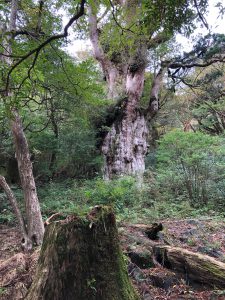 やっと来ることができました。屋久島の縄文杉は雄大で、でもどこか悲しげに迎えてくれました。屋久島の杉の歴史をトレッキングの途中でガイドさんに聞くと私は少し悲しくなってきました。江戸時代、年貢を収める成果として杉の板が献上されました。米が獲れない島故のことです。大きな杉の木、その根元から 10 メートル程度上、ちょうど真直ぐになったところで斧が入れられ大きな木が倒されました。そして切られたところから上、数十メートルまでの枝が無い部分だけが杉板の製造に使われ献上されたのです。それらの板は全国の神社仏閣の天井材に使われたそうです。残されたほとんどの部分は土埋木として放置されました。そのような切り株を多く見ることができます。樹齢 1,000 年を越える屋久杉のなかでも太く、でも真直ぐでなかった縄文杉や大王杉などは献上する板材を作るには適さなかったために切られずに残ったと聞きました。どこか虚しさを感じますね。
やっと来ることができました。屋久島の縄文杉は雄大で、でもどこか悲しげに迎えてくれました。屋久島の杉の歴史をトレッキングの途中でガイドさんに聞くと私は少し悲しくなってきました。江戸時代、年貢を収める成果として杉の板が献上されました。米が獲れない島故のことです。大きな杉の木、その根元から 10 メートル程度上、ちょうど真直ぐになったところで斧が入れられ大きな木が倒されました。そして切られたところから上、数十メートルまでの枝が無い部分だけが杉板の製造に使われ献上されたのです。それらの板は全国の神社仏閣の天井材に使われたそうです。残されたほとんどの部分は土埋木として放置されました。そのような切り株を多く見ることができます。樹齢 1,000 年を越える屋久杉のなかでも太く、でも真直ぐでなかった縄文杉や大王杉などは献上する板材を作るには適さなかったために切られずに残ったと聞きました。どこか虚しさを感じますね。
今回、お世話いただいた屋久島メッセンジャー、ガイドの安田さん、最高でした。
It has been long time I spent and finally could come to this place seeing the Jomon cedar tree. My first expression was the sadness. I was really sad seeing the tree standing so long more than 7,000 years even the age was not officially measured. The reason my sadness became the explanation by our tour guide. Most of the big cedar trees were cut for the annual contribution to the government in Edo ela because Yaku island does not have the rice farm so the contribution was the tree for shilines to construct in Japan. Some of big trees like this Jomon cedar was not cut because the style was not straight to make the wood plates or too big to cut. Therefore those big trees were still here and needed to live continuously. The other sadness I felt because the contribution was uses just the straight part of the tree that might be only 10% or less of the tree. The rest of the part was left the place. I really hope those Yaku cedar trees (more than 1,000 years old) keep longer to present the power for those travellers.
The link to the tour guide Yakushima Messenger, Mr. Yasuda was really nice person.
